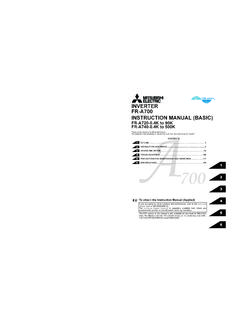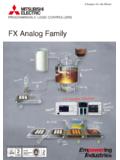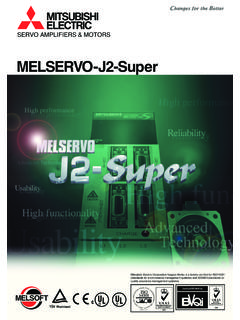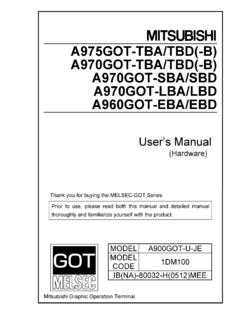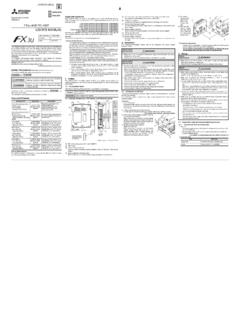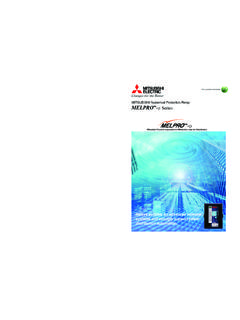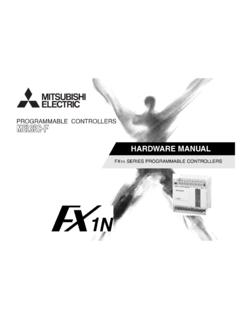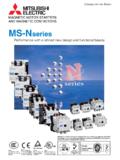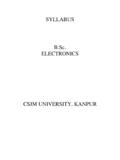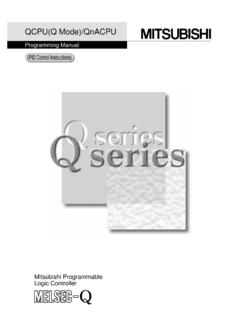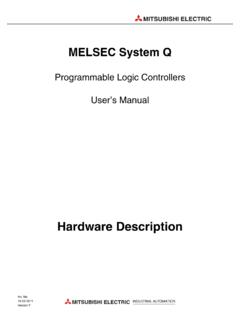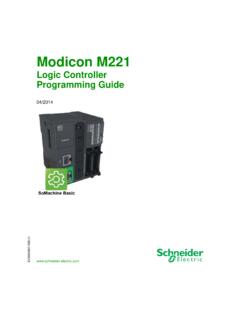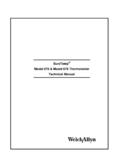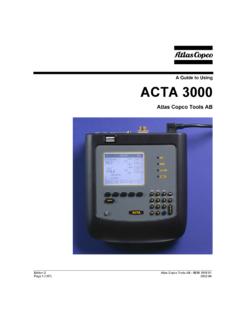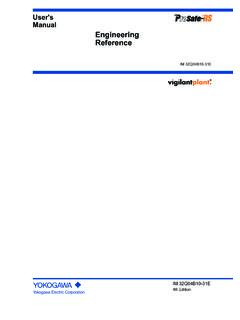Transcription of Q-series basic course(for GX Developer) - …
1 Q-series basic course (for GX Developer) Mitsubishi Programmable logic Controller Training ManualQ- series basic course (for GX Developer) Q-series basic course (for GX Developer) Mitsubishi Programmable logic ControllerTraining ManualMODELMODELCODESCHOOL-Q- basic -WIN-E 13JW50SH(NA)-080617 ENG-A(0601)MEES pecifications subject to change without exported from Japan, this manual does not require application to theMinistry of Economy, Trade and Industry for service transaction OFFICE : TOKYO BUILDING, 2-7-3 MARUNOUCHI, CHIYODA-KU, TOKYO 100-8310, JAPANNAGOYA WORKS : 1-14 , YADA-MINAMI 5-CHOME , HIGASHI-KU, NAGOYA , JAPAN SAFETY PRECAUTIONS (Always read these instructions before using the exercise.)
2 When designing the system, always read the relevant manuals and give sufficient consideration to safety. During the exercise, pay full attention to the following points and handle the product correctly. [EXERCISE PRECAUTIONS] WARNING Do not touch the terminals while the power is on to prevent electric shock. When opening the safety cover, turn off the power or conduct a sufficient check of safety before operation. Caution Follow the instructor s direction during the exercise. Do not remove the module of the demonstration machine or change wirings without permission. Doing so may cause failures, malfunctions, personal injuries and/or a fire.
3 Turn off the power before installing or removing the module. Failure to do so may result in malfunctions of the module or electric shock. When the demonstration machine (X/Y table, etc.) emits abnormal odor/sound, press "Power switch" or "Emergency switch" to turn off. When a problem occurs, notify the instructor as soon as possible. REVISIONS * The textbook number is given on the bottom left of this textbook. Print Date * Textbook number Revision Jan., 2006 SH-080617 ENG-A First edition This textbook confers no industrial property rights or any rights of any other kind, nor does it confer any patent licenses.
4 Mitsubishi Electric Corporation cannot be held responsible for any problems involving industrial property rights which may occur as a result of using the contents noted in this textbook. 2006 MITSUBISHI ELECTRIC CORPORATION CONTENTS CHAPTER 1 basics OF PLC 1- 1 to 1-14 Program .. 1- 1 Program Processing 1- 4 MELSEC-Q Module Configuration .. 1- 5 External I/O Signals and I/O 1-10 System Configuration and I/O Numbers of Demonstration Machine .. 1-13 CHAPTER 2 OPERATING GX developer 2- 1 to 2-40 basic Knowledge Required for Operating GX 1 GX developer Screen .. 2- 1 2- 3 Operation Before Creating Ladder 2- 5 Starting up the GX developer .
5 2- 5 Creating a new 2- 6 Changing the assignment of the function keys .. 2- 8 Preparations for Starting Up CPU .. 2- 9 Creating a Ladder 2-13 Creating a ladder program using the function keys .. 2-13 Creating a ladder program using the tool 2-15 Converting the Program .. 2-17 Writing to the PLC CPU .. 2-17 Monitoring the Condition of the Ladder 2-22 Editing Ladder Program .. 2-25 Making partial correction to the ladder program .. 2-25 Drawing/Deleting lines .. 2-27 Inserting/Deleting rows .. 2-30 Cutting/Copying ladder program .. 2-35 Saving Ladder Program .. 2-38 Saving newly-created or overwritten projects.
6 2-38 Saving a project under another 2-39 Reading the Saved Project .. 2-40 CHAPTER 3 PLC DEVICES AND PARAMETERS 3- 1 to 3- 4 Devices .. 3- 1 Parameters .. 3- 3 CHAPTER 4 SEQUENCE & basic INSTRUCTIONS -Part 1- 4- 1 to 4-40 List of Instructions Described in this Chapter .. 4- 1 Differences between OUT and SET RST .. 4- 4 Measuring Timer .. 4- 5 Counting by the 4- 6 [PLS] Pulse [PLF] Pulf .. 4-13 MC MCR .. 4-19 CJ SCJ CALL RET FEND .. 4-23 CJ SCJ .. 4-23 CALL (P) Call RET 4-27 FEND F end .. 4-31 Practice Questions.
7 4-34 Practice Question (1) .. 4-34 Practice Question (2) .. 4-35 Practice Question (3) .. 4-37 Practice Question (4) .. 4-38 CHAPTER 5 basic INSTRUCTION Part 2 5- 1 to 5-60 Notation of Numbers (Data) .. 5- 1 Transfer Instruction .. 5- 9 MOV (P) 16-bit data 5- 9 BIN (P) BCDBIN data conversion instruction .. 5-16 BCD (P) BINBCD data conversion instruction .. 5-18 Example of specifying digit for bit devices and data FMOV (P) FMOV (Batch transfer of the same data) BMOV (P) BMOV (Batch transfer of the block data).. 5-22 Comparison Operation Instruction.
8 5-27 Arithmetic Operations Instruction .. 5-32 (P) (P) BIN 16 bit data 5-32 * (P) / (P) BIN 16 bit 5-36 32-bit data instructions and their necessity .. 5-42 Calculation examples of multiplication/division that include decimal points (in the case where an arithmetic operation "*" or "/" is used).. 5-44 Index Register, File Register .. 5-45 How to use index register 5-45 How to use file register R .. 5-47 External Setting of the Timer/Counter Set Value, and the External Display of the Current Value .. 5-51 Practice Question .. 5-53 Practice Question (1) 5-53 Practice Question (2) BIN, BCD 5-54 Practice Question (3) 5-55 Practice Question (4) Comparison 5-56 Practice Question (5).
9 5-57 Practice Question (6) *, / .. 5-58 Practice Question (7) D*, D/ .. 5-59 CHAPTER 6 USING OTHER FUNCTIONS 6- 1 to 6-26 Clock 6- 1 Test Function at Online .. 6- 3 Turning device "Y" ON/OFF 6- 4 Setting and resetting device "M" .. 6- 5 Changing a current value of device "T".. 6- 6 Reading error steps .. 6- 7 Remote RUN/STOP .. 6- 8 Forced I/O Assignment by Parameter Settings .. 6- 9 Using Retentive 6-11 Batch Replacement of 6-13 Batch replacement of device numbers .. 6-13 Batch switching of specified devices between normally open and normally close .. 6-14 Write During 6-15 Registering 6-16 Creating Comments.
10 6-18 CHAPTER 7 PROGRAMMING INTELLIGENT FUNCTION MODULES 7- 1 to 7-22 Intelligent Function Module .. 7- 1 Data Communication between Intelligent Function Modules and CPUs .. 7- 2 I/O signals to CPUs .. 7- 2 Data communication with intelligent function modules ..7- 3 Communicating with Intelligent Function Modules .. 7- 4 Communication methods with intelligent function 7- 4 Using GX Configurator for communication .. 7- 5 Data created by GX 7- 6 Exercise System of Intelligent Function Module .. 7- 7 Q64AD Analog/Digital Conversion Module .. 7- 8 Names of parts .. 7- 8 A/D conversion 7- 9 Intelligent function module switch settings.

